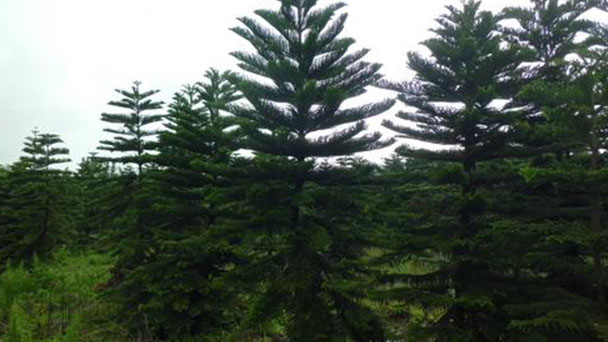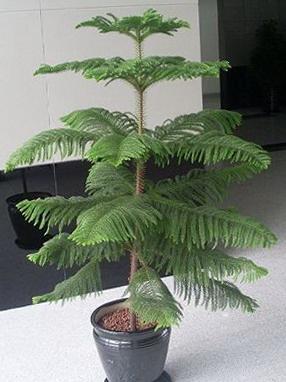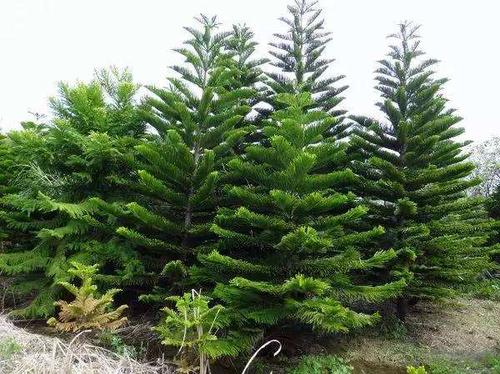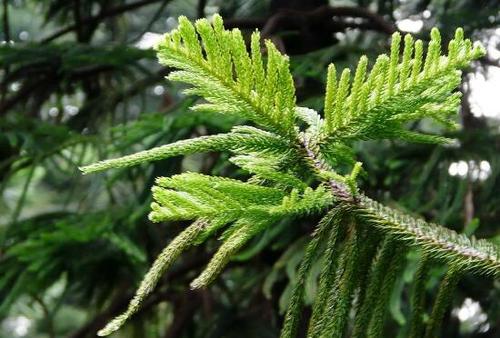Hoop pine (Araucaria cunninghamii) profile
Written by Maggie
Mar 18 2021

Hoop pine (Araucaria cunninghamii), also called colonial pine, Queensland pine, Dorrigo pine, Moreton Bay pine and Richmond River pine, is an evergreen tree, which is native to Norhoke Island, Australia.
Hoop pine picture

Morphological characteristics of hoop pine
Branch
Hoop pine is an arbor, with a height of 60 ~ 70 meters in its native place and a diameter at breast height of more than 1 meter. The bark is gray-brown or dark gray, coarse and transverse. Branches are flat or oblique extension, sapling crown pinnacle shape, old is into flat top shape, lateral branchlets dense, drooping, nearly pinnate arrangement.
Leaf
Hoop pine leaf type is: saplings and lateral branch leaves loosely arranged, developed, and the cone, acicular, sickle, or triangular, 7 ~ 17 mm long, base width is about 2.5 mm, slightly curved, micro four edges or (abdomen) on the ridges, with the majority of stomatal lines, stomatal lines not neat or nearly free of stomatal lines below, upper gradually narrow, apex acuminate or slightly acute cusp; hoop pine leaves of large branches and flowering fruit branches are densely overlapping, obliquely extended, slightly curved upward, ovate, triangular-ovate or triangular-ovate, without obvious dorsal or with a longitudinal ridge below, 6 -- 10 mm long.
Fruit
The cones of Hoop Pine are ovoid or elliptic, 6-10 cm long and 4 cm wide, wide at base, tapered or slightly rounded at top, acute or obtuse at apex, conspicuous or inconspicuous at midrib, grey-green above with white powder and many stomatal lines, green below, with only irregular sparse stomatal lines at middle and lower part. Male cones are solitary branch apex, cylindrical.
Cones of Hoop pine are ovate or elliptic, 6 -- 10 cm long, 4.5 -- 7.5 cm in diameter; Bract scales cuneiform obovate, with thin wings on both sides, broad and thick at the apex, with sharp ridges, a long caudate tip with acute acuminate in the center, the tip is conspicuously retroflexed; The apex of a grove is thin, not hypertrophic; Seeds are elliptic, with membranous wings on both sides of a union.
The ecological habits of hoop pine
Hoop pine is light-loving, seedlings are shaded; Hoop pine is fond of warm and humid climate and can not tolerate drought and cold. Hoop pine likes fertile soil. Hoop pine has fast growth, strong tillering ability, strong wind resistance.
Hoop pine needs sufficient sunshine in winter and avoids strong light exposure in summer. It is afraid of the dry wind in northern spring and the scorching sun in midsummer. Hoop pine grows best under the environmental conditions of temperature 25℃ -- 30℃ and relative humidity above 70%. Potted requirements loose and fertile, humus content is higher, drainage breathable strong cultivation soil.
The propagation of hoop pine
Seed propagation
Sowing method of propagation because of the seed coat solid, low germination rate, so it is best to break the seed coat before planting, to promote its germination. In addition, seedlings planted are vulnerable to pests and diseases, so the soil used should be strictly disinfected. Seeds of Hoop pine had better push bud by sand bed or above breaking shell sowing method, in order to improve the germination rate of seeds, generally about 30 days or so can germinate.
Cutting propagation
Cuttage propagation of Hoop pine is easy and widely used. Generally in spring, summer cuttings, but must choose the main branch as cuttings, with lateral branches as cuttings grow into plants skewed and not straight and straight. The cuttings are 10 to 15 cm long and can take root in about 4 months after insertion at 18℃ to 25℃ and high air humidity. If the base of cuttings is soaked with 200 PPM indolebutyric acid (IBA) for 5 hours before cutting, it can promote its early rooting.
To obtain more main branches as cuttings, saplings can be cut to the top, so that the top of the shoot produces many upright new shoots, spring cut as cuttings. This kind of mother plant with cut top can still grow top bud, which is used for permanent propagation of mother plant. The potted Hoop Pine soil should be a mixture of 40% peat soil, 40% leaf rot soil and 20% river sand. During the growing period, the soil should be kept moist. If it is too dry, it will make the lower leaves sag soft, but it should be kept slightly dry in winter. Winter room temperature should be maintained at more than 5%, low temperature will make the growing point frozen dead.
High pressure propagation
If there are conditions in the shed, the Hoop pine can be peeled at the appropriate height after the whole plant in the ground, buried incision depth of more than 10 cm. About 1 ~ 2 years the plant is strong and the new root is long, and then the plant is put on the pot. At this time, the original old root has decayed and can be removed. The new plant is short and strong and more resistant to ornamental.

Disease & pest control of hoop pine
Disease control
Anthrax
Prevention and control methods:
1. Clean the field, remove the sick and disabled bodies in time, carry them out of the field and burn them or bury them deep.
2. At the beginning of the disease, spray 50% carbendazim wettable powder 700 times liquid or more than 40%.Sulphur suspension agent 600 times the liquid, once every 7-10 days, 3-4 times continuous control.
Leaf blight
Prevention and control methods:
Refer to the control of leaf blight of Chinese Hoop pine. It can also spray 40% polysulfide gum suspension 600 times liquid, or 30% cuprous chloride gum suspension 600 times liquid, or 25% nitrilazole emulsion 8000 times liquid, or 40% fluosilazole emulsion 8000 times liquid, or 50% methyl hydroxonium water agent 1500 times liquid, or 69% Anke manganese zinc +75% chlorothalonil wet-able powder 1500 times liquid, or 65% Doc bacteria wet-able powder 600 times liquid. In the garden garden with frequent disease, in the winter and spring period combined with the garden immediately spray once, the ground and the tree spray combined, the effect is better.
Pest control
Scale insects
Prevention and control methods:
It can be treated with a 40% dimethoate solution of 1000 ~ 1500 times.
Leaves turn yellow
The reasons for the yellow leaves of Hoop pine can be summarized as the following five points:
1. The light is too weak.Hoop pine grows well if it is conserved in a place with good light. If it is conserved in a place with good light for a long time, it will show the phenomenon of leaf yellowing and accompanied by leaf shedding. Therefore, its tracer should be moved to a place with better light, otherwise the plant will further aggravate the disease.
2. Excessive watering. The watering principle of Hoop pine is not to water too much or too often when it is wet or dry. The soil in the pot is not watered, otherwise the root system will rot due to hypoxia, which makes it difficult to absorb water and nutrients, and the plant will show symptoms of discomfort.
3. Low temperature or high temperature harm.Hoop pine leaves turn yellow and shed a little when the temperature drops below 5 degrees C. If the air humidity is low during the high temperature period, a large number of yellow leaves will appear.
4. Too low air humidity or too strong wind causes acute dehydration and yellowing of leaves. This needs to be placed in the shelter, or often spray, sprinkle water, to improve the air humidity.
5. Infection of disease. Usually use carbendazim, chlorothalonil and other drugs to spray prevention.
Variety classification of hoop pine
Hoop pine Araucaria bidwillii Hook.
Hoop pine Araucaria heterophylla (Salisb.) Franco
The distribution area of Hoop pine
Hoop pine is native to South America, Australia and the Pacific Islands, and southeast coastal areas of Queensland, Oceania. Hoop pine is cultivated in Guangdong, Fujian, Hainan, Yunnan and Guangxi in China.
Hoop pine is grown in pots and overwintered in a greenhouse in the Yangtze River valley and other big cities to the north.
The use of hoop pine
Ornamental value
Hoop pine is a tall and graceful tree. Hoop pine is named as one of the world's top five park trees, together with cedar, Japanese golden pine, North American redwood and Chinese pine. Most suitable for planting alone as a landscape tree or as a memorial tree, but also as a street tree. However, it is advisable to choose a location without strong winds so as to avoid tree canopy deviation. Hoop pine is also a valuable indoor potted ornamental tree. Hoop pine is a beautiful landscaped tree. It can be planted alone, in rows or in bushes. Hoop pine can also be used as a background tree for large sculpture or landscape architecture. Hoop pine is also a precious indoor potted ornamental tree, which is used to decorate the hall environment and looks very elegant.
Hoop pine is one of the most famous garden trees in the world. It has the shape of a pinnacle with lush branches and triangular or oval leaves. Hoop pine can be planted, isolated or with trees, and can also be used as a background tree for sculpture or landscape architecture. Hoop pine can also be used as a street tree, but it is advisable to choose a location without strong wind, so as not to skew the tree crown. Seedling bonsai is suitable for the decoration of the sitting room, corridor and study of the general family; It can also be used to decorate various forms of meeting hall, exhibition hall; Hoop pine can also be used as a gift for relatives and friends to start business and move to another place.
Timber value
Hoop pine is an important timber tree in Australia and South Africa. Hoop pine can be used for construction, appliances and furniture.

Latest Updated
- Benefits of Bugleweed - 7 Science-backed Health Benefits
- Bugleweed Dangers & Side Effects - Is It Poisonous?
- How to Plant Evergreen Trees - What You Should Know
- When to Plant Evergreens - Grow Guide for Evergreen Trees
- 12 Wonderful Evergreen Shrubs for Your Garden
- 12 Popular Evergreen Plants with Pictures for Beginners
- When And How To Prune A Lilac Bush Like a Pro
- How to Grow & Care for Lilac Vine (Hardenbergia Violacea)
- Japanese Lilac Tree (Syringa Reticulata) Care & Propagation Guide
- Shumard Oak Pros and Cons - What to Know
Popular Articles
- Winter maintenance of Antirrhinum Majus
- How to Grow Terminalia Mantaly Tree
- How to Grow and Care for Crossostephium Chinense
- How to grow Antirrhinum Majus in spring
- Peristeria Elata (Dove Orchid) Profile: Info & Care Guide
- Underwatered Snake Plant (Sansevieria Trifasciata) - Signs And How To Fix
- How to Care for Brazilian Jasmine Plant (Mandevilla Sanderi)
- How to Grow & Care for Graptopetalum Purple Delight in Summer
- Rosa Chinensis (China Rose): Plant Growing & Care Tips
- How to Care for Baby Sun Rose (Aptenia Cordifolia)